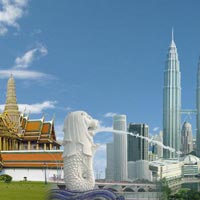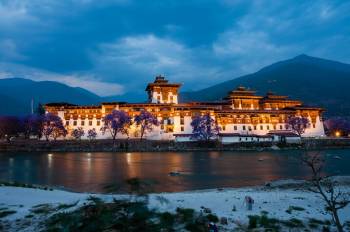10 Nights / 11 Days

Bhutan “The land of the thunder dragon” is a landlocked country in Asia. It is covered by China in the north and other three sides are covered by India. Bhutan's landscape ranges are from subtropical plains in the south to the sub-alpine Himalayan heights in the north. Bhutan is one of the culturally rich countries of Asia. A majority people of the Bhutan are of Tibetan origin and follow a sect of Tibetan Buddhism. Tiger's Nest Monastery, 8th century Kichu Monastery, and the national museum is some conserved masterpiece in Paro.
Stay Safe
Altitude Sickness: The main and common risk while trekking above about 2500m is Altitude sickness. Altitude sickness is caused by acute exposure to low partial pressure of oxygen at high altitude. The available amount of oxygen to sustain mental and physical alertness decreases with altitude. Available oxygen drops as the air density itself, the number of molecules (of both oxygen and nitrogen) per given volume, drops as altitude increases. So don’t ignore, if you have any symptoms then descending to a lower altitude is the only option.
Water: Have some means to purify water, iodine or a fine ceramic filter are the best options. The streams should be considered polluted and whilst bottled water is often available, the disposal of plastic bottles is a problem.
Electricity in Nepal
Nepal is a developing country, Outside of major cities area electricity on trekking can be scares. You should have to pay 100-800 NRs per hour to charge goods on many lodges and also many tea-house treks, including in Annapurna base camp trek, Everest Base camp trek and many others treks also. Chargers often won't work on low power solar systems you find right up in the mountains so u can buy alternative bayonet light to electricity power plug converter, which will only works in low voltage is highlow. The standard Nepalese electrical outlet is a three-pronged triangle so bring three-pronged triangle chargers.
Nepal Climate information
Nepal is a landlocked country which lies in Hindu Kush Himalayan region. Nepal has monsoonal climate having four main seasons: spring, summer, monsoon, autumn and winter.
Below is a general guide to conditions at different seasons:
January to March (winter): In this season temperature will decrease at often 0°C (32°F) at night, with extreme cold at high elevations. It is possible to trek in places like the Everest region during the winter but due to extreme cold weather and heavy snow fall it may be quite difficult than as usual.
April to June (summer): In these months it is quite warm and dry weather. There is an abundance of blooming flowers in the Himalayas at this time, with rhododendrons, in particular, adding a splash of color to the landscape. This season is the best time to undertake mountain expeditions.
June to September (Monsoon): There will be heavy monsoonal rainfall in this season. Rains are generally lighter in high Himalayan reasons. In this season the mountain ranges are not often visible due to the clouds.
October to December (autumn): These months are cool and clear which is due to the end of monsoon, there is little dust in the air so this is the best season to visit the hilly and mountainous regions.
Nepal Visas information
Visa in Nepal can be acquired on arrival at Tribhuwan International Airport, Kathmandu and also at the border entry points in Kakadvitta, Birgunj, Bhairahawa, Nepalgunj, Gaddachowki border of Nepal - India and Kodari on Nepal-China border. Visa can also acquire at the nearest Nepal Embassy. For visa renewal purpose you can contact at Department of Immigration, Kalikasthan at Kathmandu. A valid passport and one passport -size photo with a light background is required. Visa can be obtained only through payment of cash in the following currency: Euro, Swiss Franc, Pound Sterling, US Dollar, Australian Dollar, Canadian Dollar, Hong Kong Dollar, Singapore Dollar and Japanese Yen. Credit card, Indian currency and Nepali currency are not accepted as payment of visa fee.
Visa Facility Duration Fee
Multiple entry 15 days US$ 25 or equivalent convertible currency
Multiple entry 30 days US$ 40 or equivalent convertible currency
Multiple entry 90 days US$ 100 or equivalent convertible currency
Respect to Local Peoples
In Nepal, “Namaste” or “Namaskar” is said to an older or high-status person with palms together, figure up. It is used to greet a person in place of goodbye or hello. There is no limitation how many times you say “Namaste” but, it is better if you say once per person, per day. If You want to say “Thank You” then you can say “Dhanyabaad /'ðɅnjɅbɑ:d/ (Dhan-ya-baad)”
Arrive at TIA (Tribhuwan International airport) Kathmandu, Nepal. Then move to respective hotels and then rest there.
And in this day we will take a flight to Paro international airport, Paro. During the flight we can have a nice view of mountains like Mt. Everest, Kanchenjunga…and many more in Nepal and some mountains in Bhutan. And transfer to Thimphu (7,725'), the capital city of Bhutan.
In this day we will day hike through the forested countryside to centuries-old Cheri and Tango monasteries which lies just to the north of Thimphu.
After sightseeing to the Folk Heritage and Textile Museums, and the School of Arts and Crafts in Thimpu we will drive to Punakha valley.
Then in this day we will hike to Taktsang Monastery which is also called “Tiger’s Nest” which is jst above the paro valley.
Then in this day we will drive to the Haa Valley along the western border of Bhutan. And in afternoon we will visit LhakhangKarpo which is also called "Temple of the White Dove".
Then from this day we will start our trek we will trek to Saga la camp there for the night near Saga La pass.
Then we continue our trekking and camp at Ningula
Then we will trek through forests of pine, dwarf rhododendron, and primulas to a ridge with high mountain views then return to Paro.
Return back to Kathmandu. In afternoon you can roam around Kathmandu valley. Overnight at hotel
After breakfast we will transfer you to Tribhuvan International airport (TIA) three hour before your flight you have to reach there
Actual Adventure Pvt. Ltd comprises of a group of experienced, proactive and enthusiastic persons who are highly motivated to promote and bring forth to the world the unparallel natural wonders of Nepal in a sustainable manner. With the inception of our company in 2009 Read More...
 14D/13N
14D/13N
 10D/9N
10D/9N
 14D/13N
14D/13N
Jomsom Muktinath with Chitwan Jeep Safar..
Kathmandu - Pokhara - Chitwan - Kathamdnu
 15D/14N
15D/14N
 1D/0N
1D/0N
 5D/4N
5D/4N
 22D/21N
22D/21N
 3D/2N
3D/2N
 8D/7N
8D/7N
 11D/10N
11D/10N
 11D/10N
11D/10N
 11D/10N
11D/10N
 11D/10N
11D/10N
Bhopal - Pachmarhi - Jabalpur - Gwalior - Chhatarpur - Tikamgarh - Umaria
 11D/10N
11D/10N
 11D/10N
11D/10N
 11D/10N
11D/10N
Best of Gujarat With Wildlife Tour
Ahmedabad - Bhavnagar - Diu - Junagadh - Rajkot - Bhuj - Jamnagar - Dwarka - Mumbai
 11D/10N
11D/10N
 11D/10N
11D/10N
 12D/11N
12D/11N
11 Nights - 12 Days Nepal Tour From Gora..
Prayagraj - Gorakhpur - Varanasi - Ayodhya - Kathmandu - Pokhara - Chitwan - janakpur
 12D/11N
12D/11N
11 Nights - 12 Days Nepal Tour From Gora..
Prayagraj - Gorakhpur - Varanasi - Ayodhya - Kathmandu - Pokhara - Chitwan - janakpur
 12D/11N
12D/11N
11 Nights - 12 Days Nepal Tour Package - 2
Prayagraj - Gorakhpur - Varanasi - Ayodhya - Kathmandu - Pokhara - Chitwan - janakpur
 12D/11N
12D/11N
Prayagraj - Gorakhpur - Varanasi - Ayodhya - Kathmandu - Pokhara - Chitwan - janakpur
 8D/7N
8D/7N
8D Kathmandu - Chitwan - Pokhara - Lumbi..
Kathmandu - Pokhara - Lumbini - Chitwan - janakpur
 3D/2N
3D/2N
 5D/4N
5D/4N
 6D/5N
6D/5N
 7D/6N
7D/6N
6 Nights/ 7 Days - Bhutan Happiness Tour
Punakha - Bumthang - Paro - Thimphu - Phobjik